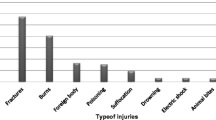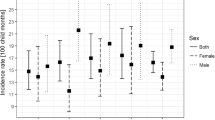Abstract
Background
Children 0–14 years constitute about 31.4% of Indian population, among whom the magnitude and risk factors of childhood injuries have not been adequately studied.
Objective
To study the prevalence of and assess the factors associated with unintentional injuries among children aged 6 month–18 years in various regions.
Methodology
This multi-centric, cross-sectional, community-based study was conducted at 11 sites across India. States included were Gujarat, Karnataka, Madhya Pradesh, Punjab, Sikkim, Tamil Nadu, Uttarakhand, and West Bengal between March, 2018 and September, 2020. A total of 2341 urban and rural households from each site were selected based on probability proportionate to size. The World Health Organization (WHO) child injury questionnaire adapted to the Indian settings was used after validation. Information on injuries was collected for previous 12 months. Definitions for types (road traffic accidents, falls, burns, poisoning, drowning, animal-related injuries) and severity of injuries was adapted from the WHO study. Information was elicited from parents/primary caregivers. Data were collected electronically, and handled with a management information system.
Results
In the 25751 households studied, there were 31020 children aged 6 months–18 years. A total of 1452 children (66.1% males) had 1535 unintentional injuries (excluding minor injuries) had occurred in the preceding one year. The overall prevalence of unintentional injuries excluding minor injuries was 4.7% (95% CI: 4.4–4.9). The commonest type of injury was fall-related (842, 54.8%) and the least common was drowning (3, 0.2%). Injuries in the home environment accounted for more than 50% of cases.
Conclusions
The findings of the study provide inputs for developing a comprehensive child injury prevention policy in the country. Child safe school with age-appropriate measures, a safe home environment, and road safety measures for children should be a three-pronged approach in minimizing the number and the severity of child injuries both in urban and rural areas.
Similar content being viewed by others

References
Dunbar G, Hill R, Lewis V. Children’s attentional skills and road behavior. J Exp Psychol Appl. 2001;7:227–34.
National Crime Record Bureau. Accidental deaths and suicides in India. 2018.
Gururaj G. Injury prevention and care: An important public health agenda for health, survival and safety of children. Indian J Pediatr. 2013;80:100–8.
World Health Organization. Guidelines for Conducting Community Surveys on Injuries and Violence. World Health Organization; 2004.
Census of India, 2011. Provisional Population Totals. New Delhi: Office of the Registrar General and Census Commissioner. 2011.
World Health Organization. International statistical classification of diseases and related health problems: Tabular list. World Health Organization; 2004.
Majori S, Bonizzato G, Signorelli D, et al. Epidemiology and prevention of domestic injuries among children in the Verona area (north-east Italy). Ann. 2002;14:495–502.
Mathur A, Mehra L, Diwan V, et al. Unintentional childhood injuries in urban and rural Ujjain, India: A community-based survey. Children (Basel). 2018;5:23–32.
Tripura K, Das R, Datta SS, et al. Prevalence and management of domestic injuries among under five children in a peri-urban area of Agartala, Tripura. Health Agenda. 2015;3:41–5.
Nanda Kumar BS, Madhumitha M, Ramaprasad A, et al. National healthcare programs and policies in India: An ontological analysis. International Journal of Community Medicine and Public Health. 2017;4:307–13.
Peden M, Kayede O, Ozanne-Smith J, et al. World report on child injury prevention: World Health Organization; 2008–2018.
Zaidi SHN, Khan Z, Khalique N. Injury pattern in children: A population-based study. Indian J Community Health. 2013;25:45–51.
Murray CJ, Lopez AD. The global burden of disease: A comprehensive assessment of mortality and disability from diseases, injuries, and risk factors in 1990 and projected to 2020: Summary. World Health Organization; 1996.
Parmeswaran GG, Kalaivani M, Gupta SK, et al. Unintentional childhood injuries in urban Delhi: A community-based study. Indian J Community Med. 2017;42:8–12.
Peden M, Oyegbite K, Ozanne-Smith J, et al. World report on child injury prevention. World Health Organization; 2009.
Bagri N, Saha A, Chandelia S, et al. Fireworks injuries in children: A prospective study during the festival of lights. Emerg Med Australas. 2013;25:452–6.
Hyder AA, Sugerman DE, Puvanachandra P, et al. Global childhood unintentional injury surveillance in four cities in developing countries: A pilot study. Bull World Health Organ. 2009;87:345–52.
Pal S, Patra DK, Roy B, et al. Profile of accidental poisoning in children: Studied at urban based tertiary care centre. Saudi J Med Pharma Sci. 2019:1110–3.
Sudarshan MK, Narayana DHA. Appraisal of surveillance of human rabies and animal bites in seven states of India. Indian J Public Health. 2019;63:3–8.
Mutto M, Lawoko S, Nansamba C, et al. Unintentional childhood injury patterns, odds, and outcomes in Kampala City: An analysis of surveillance data from the National Pediatric Emergency Unit. J Inj Violence Res. 2011;3:13–8.
Acknowledgement
Pankaj Gupta, ICMR, New Delhi. Kaushal Swaroop S, Kavin Corporation, Bangalore.
Author information
Authors and Affiliations
Consortia
Corresponding author
Additional information
Full list of co-investigators and task force members provided as annexure.
Ethical clearance
Institutional Ethics Committees; Ramaiah Medical College, Bangalore; MSRMC/EC/2018, dated February 5, 2018; GCS Medical college, Hospital and Research Centre, Ahmedabad; GCSMC/EC/TRIAL/APPROVE/2018/24, dated January 28, 2018; AIIMS, Bhopal; IHEC-LOP/2018/EF0077, dated January 27, 2018; Vellalar College for Women, Erode; IEC/VCW/HR/2017/001, dated March 20, 2017; Kasturba Medical College, Mangalore; IECKMCMLR/03-17/42, dated March 15, 2017; PDU Medical College, Rajkot; PDUMCR/IEC/11097, dated June 16, 2017; SRM university, Sikkim; SRMUS/MS/IEC/2018-01, dated February 10, 2018; VCSG Government Institute of Medical Sciences and Research, Pauri Garhwal; IEC/VCSGGMSI&R/2018/027, dated January 18, 2018; Christian Medical College, Vellore; IRB/10648/OBS; April 19, 2017; DMC & H-Ludhiana, Punjab; IRB/DMC & H XX/2017, and Burdwan Medical College, West Bengal; IEC/BMCXX/2017.
Contributors
All authors approved the final version of manuscript and are accountable for all aspects related to the study.
Funding
Indian Council of Medical Research
Competing interests
None stated.
Rights and permissions
About this article
Cite this article
Nooyi, S.C., Sonaliya, K.N., Dhingra, B. et al. Descriptive Epidemiology of Unintentional Childhood Injuries in India: An ICMR Taskforce Multisite Study. Indian Pediatr 58, 517–524 (2021). https://doi.org/10.1007/s13312-021-2233-3
Received:
Revised:
Accepted:
Published:
Issue Date:
DOI: https://doi.org/10.1007/s13312-021-2233-3



